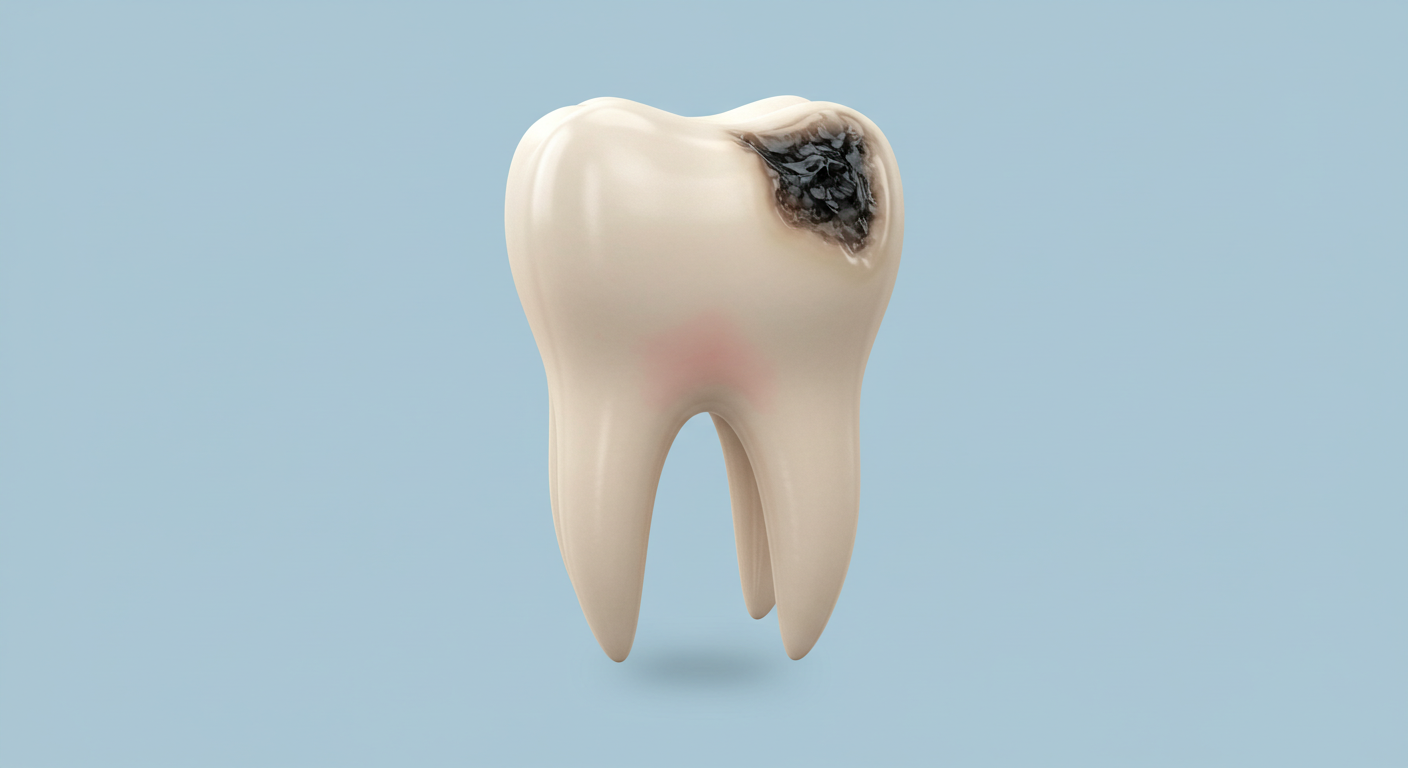Contents

How to Detect and Treat an Early Cavity in Time: A Complete Guide
Dental cavities are one of the most common oral diseases, caused by the progressive destruction of enamel and dentin due to bacteria, a high-sugar diet, and poor hygiene habits. If an early cavity is not treated promptly, it can evolve into a serious infection, affecting the dental pulp, causing an abscess, or even tooth loss.
Discover in this article how to spot the first signs, understand the stages of cavity development, and adopt the right habits for optimal dental health.
What Is an Early Cavity and How to Spot It?
A cavity begins as an infectious disease related to the action of bacteria naturally present in the mouth. These bacteria, harmless in small quantities, become problematic when combined with food debris, saliva, and sugars. This interaction forms dental plaque, which attacks the enamel, the protective layer of the tooth, before penetrating deeper into the dentin.
In its initial stage, a cavity is often silent: it causes no particular pain or discomfort. However, certain signs can be a warning:
- White or brown spots on the tooth surface, visible in the grooves or between the teeth.
- Increased sensitivity to hot, cold, sweet, or acidic foods, or when chewing.
- A rough texture or slight discoloration on the enamel.
These symptoms can be difficult to detect with the naked eye. An X-ray or a thorough examination by a dentist is often necessary to confirm an early cavity. If you notice any of these signs, see a professional quickly for an accurate diagnosis and to prevent worsening.
The 4 Stages of Cavity Development
Dental care varies depending on the progression of the cavity. Early intervention reduces the complexity and cost of treatments. Here are the four typical stages:
1. Initial Stage: Enamel Attack
In the first stage, the cavity only affects the enamel, the outermost and hardest layer of the tooth. It often forms in the grooves or interdental spaces where plaque accumulates. With no pain or sensitivity at this stage, the cavity can go unnoticed.
Possible Solutions:
- Application of a fluoride varnish to remineralize the enamel.
- Placing a dental sealant over the grooves to prevent progression.
2. Intermediate Stage: Dentin Involvement
If the cavity progresses, it passes through the enamel to reach the dentin, a softer layer underneath. At this stage, slight pain or increased sensitivity may appear. The dentist removes the infected tissue, usually under local anesthesia.
Common Treatments:
- Placing a filling (composite or amalgam) to fill the cavity.
3. Advanced Stage: Deep Dentin
The cavity then reaches deep into the dentin, causing significant loss of tooth structure. The patient often feels more intense pain. The dentist may need to place a larger restoration like an onlay or inlay.
4. Critical Stage: Pulp Involvement
At this stage, the cavity has reached the pulp, where the nerves and blood vessels are located. The infection causes severe pain, inflammation (pulpitis), or an abscess. The only solution is often a root canal treatment, which involves removing the infected pulp, cleaning the canals, and sealing them. A dental prosthesis like a crown is then typically needed to restore the tooth's function and appearance.
What Are the Risks of an Untreated Cavity?
If a cavity is not treated, the consequences can be serious:
- Intense Pain: Pulpitis or an abscess can cause a throbbing toothache.
- Tooth Loss: Without intervention, the decayed tooth deteriorates completely, requiring an extraction. A prosthesis or dental implant will then be required.
- Systemic Complications: Bacteria can spread to the gums, ligaments, bone, or even the bloodstream, causing infections. Patients with diabetes, cancer, or cardiovascular/pulmonary diseases are particularly vulnerable.
- Impact on Well-being: Chronic fatigue or sleep disturbances can occur due to pain or discomfort.
How to Prevent and Treat an Early Cavity?
Prevention: The Right Habits
To prevent the onset or progression of cavities:
- Rigorous oral hygiene: Brush twice a day with fluoride toothpaste, and use floss and interdental brushes.
- Reduce sugars: Limit sugary foods and drinks that feed bacteria.
- Chew sugar-free gum: This stimulates saliva, which helps neutralize acids.
- Regular dental visits: A check-up every 6 to 12 months allows for early detection and treatment of cavities.
Early Treatments
If an early cavity is detected:
- Remineralization: A fluoride varnish or gel can strengthen the enamel.
- Sealants: A protective barrier is applied to the teeth to block bacteria.
- Filling or restoration: For more advanced stages, a composite or amalgam is used to repair the tooth.
Why See a Dentist Promptly?
Early intervention is crucial to limit the damage. A cavity does not heal on its own: only a dentist's action can stop its progression before it reaches deep tissues. An annual or semi-annual visit, even without symptoms, is essential for maintaining optimal dental health.
Conclusion
Detecting and treating an early cavity in time is the key to preserving your teeth and avoiding painful or costly complications. By adopting good oral hygiene, reducing sugar intake, and seeing your dentist regularly, you can prevent cavities or treat them effectively at an early stage. If you notice any spots, sensitivity, or pain, don't wait: a quick diagnosis can make all the difference for your smile and your overall health!
FAQ
How do I know if I have an early cavity?
Look for white or brown spots on your teeth, sensitivity to hot/cold foods, or a rough texture. A dentist can confirm with an X-ray.
Can a cavity go away on its own?
No, a cavity does not heal without treatment. Only dental intervention can stop its progression.
How much does treating an early cavity cost?
The price for a simple filling varies widely but can range from $100 to $300, depending on the material and location. It is typically covered in part by dental insurance.
